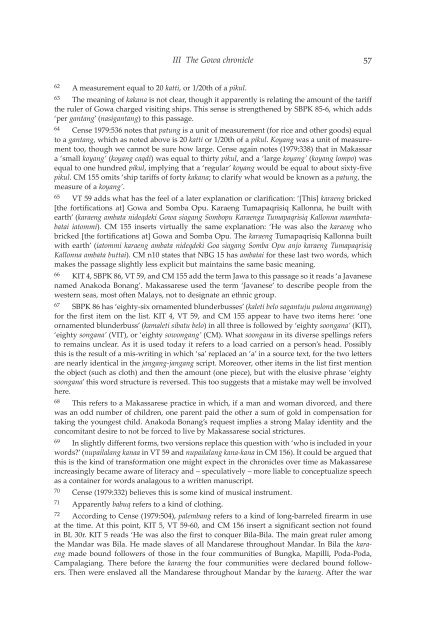A CHAIN OF KINGS - Books and Journals
A CHAIN OF KINGS - Books and Journals
A CHAIN OF KINGS - Books and Journals
You also want an ePaper? Increase the reach of your titles
YUMPU automatically turns print PDFs into web optimized ePapers that Google loves.
62 A measurement equal to 20 katti, or 1/20th of a pikul.<br />
III The Gowa chronicle 57<br />
63 The meaning of kakana is not clear, though it apparently is relating the amount of the tariff<br />
the ruler of Gowa charged visiting ships. This sense is strengthened by SBPK 85-6, which adds<br />
‘per gantang’ (nasigantang) to this passage.<br />
64 Cense 1979:536 notes that patung is a unit of measurement (for rice <strong>and</strong> other goods) equal<br />
to a gantang, which as noted above is 20 katti or 1/20th of a pikul. Koyang was a unit of measurement<br />
too, though we cannot be sure how large. Cense again notes (1979:338) that in Makassar<br />
a ‘small koyang’ (koyang caqdi) was equal to thirty pikul, <strong>and</strong> a ‘large koyang’ (koyang lompo) was<br />
equal to one hundred pikul, implying that a ‘regular’ koyang would be equal to about sixty-five<br />
pikul. CM 155 omits ‘ship tariffs of forty kakana; to clarify what would be known as a patung, the<br />
measure of a koyang’.<br />
65 VT 59 adds what has the feel of a later explanation or clarification: ‘[This] karaeng bricked<br />
[the fortifications at] Gowa <strong>and</strong> Somba Opu. Karaeng Tumapaqrisiq Kallonna, he built with<br />
earth’ (karaeng ambata nideqdeki Gowa siagang Sombopu Karaenga Tumapaqrisiq Kallonna naambatabatai<br />
iatommi). CM 155 inserts virtually the same explanation: ‘He was also the karaeng who<br />
bricked [the fortifications at] Gowa <strong>and</strong> Somba Opu. The karaeng Tumapaqrisiq Kallonna built<br />
with earth’ (iatommi karaeng ambata nideqdeki Goa siagang Somba Opu anjo karaeng Tumapaqrisiq<br />
Kallonna ambata buttai). CM n10 states that NBG 15 has ambatai for these last two words, which<br />
makes the passage slightly less explicit but maintains the same basic meaning.<br />
66 KIT 4, SBPK 86, VT 59, <strong>and</strong> CM 155 add the term Jawa to this passage so it reads ‘a Javanese<br />
named Anakoda Bonang’. Makassarese used the term ‘Javanese’ to describe people from the<br />
western seas, most often Malays, not to designate an ethnic group.<br />
67 SBPK 86 has ‘eighty-six ornamented blunderbusses’ (kaleti belo sagantuju pulona angannang)<br />
for the first item on the list. KIT 4, VT 59, <strong>and</strong> CM 155 appear to have two items here: ‘one<br />
ornamented blunderbuss’ (kamaleti sibatu belo) in all three is followed by ‘eighty soongana’ (KIT),<br />
‘eighty songana’ (VIT), or ‘eighty sowongang’ (CM). What soongana in its diverse spellings refers<br />
to remains unclear. As it is used today it refers to a load carried on a person’s head. Possibly<br />
this is the result of a mis-writing in which ‘sa’ replaced an ‘a’ in a source text, for the two letters<br />
are nearly identical in the jangang-jangang script. Moreover, other items in the list first mention<br />
the object (such as cloth) <strong>and</strong> then the amount (one piece), but with the elusive phrase ‘eighty<br />
soongana’ this word structure is reversed. This too suggests that a mistake may well be involved<br />
here.<br />
68 This refers to a Makassarese practice in which, if a man <strong>and</strong> woman divorced, <strong>and</strong> there<br />
was an odd number of children, one parent paid the other a sum of gold in compensation for<br />
taking the youngest child. Anakoda Bonang’s request implies a strong Malay identity <strong>and</strong> the<br />
concomitant desire to not be forced to live by Makassarese social strictures.<br />
69 In slightly different forms, two versions replace this question with ‘who is included in your<br />
words?’ (nupailalang kanaa in VT 59 <strong>and</strong> nupailalang kana-kana in CM 156). It could be argued that<br />
this is the kind of transformation one might expect in the chronicles over time as Makassarese<br />
increasingly became aware of literacy <strong>and</strong> ‒ speculatively ‒ more liable to conceptualize speech<br />
as a container for words analagous to a written manuscript.<br />
70 Cense (1979:332) believes this is some kind of musical instrument.<br />
71 Apparently babuq refers to a kind of clothing.<br />
72 According to Cense (1979:504), palembang refers to a kind of long-barreled firearm in use<br />
at the time. At this point, KIT 5, VT 59-60, <strong>and</strong> CM 156 insert a significant section not found<br />
in BL 30r. KIT 5 reads ‘He was also the first to conquer Bila-Bila. The main great ruler among<br />
the M<strong>and</strong>ar was Bila. He made slaves of all M<strong>and</strong>arese throughout M<strong>and</strong>ar. In Bila the karaeng<br />
made bound followers of those in the four communities of Bungka, Mapilli, Poda-Poda,<br />
Campalagiang. There before the karaeng the four communities were declared bound followers.<br />
Then were enslaved all the M<strong>and</strong>arese throughout M<strong>and</strong>ar by the karaeng. After the war









![Am HaSefer [Volk des Buches] - Books and Journals](https://img.yumpu.com/20648352/1/174x260/am-hasefer-volk-des-buches-books-and-journals.jpg?quality=85)







